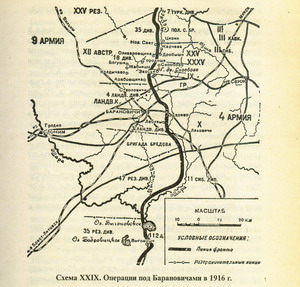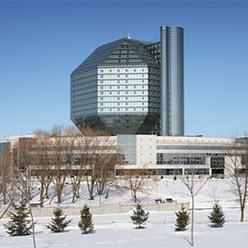
Baranovichi operation
 Occupation of Baranovichi by German troops
Occupation of Baranovichi by German troops
On 1 August, 1914, the First World War started. From its very beginning in Baranovichi and vicinities there were concentrated large military forces. The military destiny of Baranovichi was unique: during the first year of the war the Supreme Commander-in-Chief’s Headquarters had been located in the town. The general staff of all armed forces of Russia represented a site of railroad tracks with cars located in the wood. The Russian emperor had often arrived in there having spent in the Headquarters about two months in sum and visited Baranovichi about 10 times.
During the last stay in Baranovichi (11–28 June, 1915) Nicholas II held an extraordinary session of the Ministerial Council at which the questions of the state importance caused by the wartime were solved. In connection with the frontline approaching and the retreat of the Russian army on 9 August, 1915, the Headquarters were moved to Mogilev.
The war caused devastation to Baranovichi. A part of population was mobilized; civilians remaining in the town bore impoverishment, mass evacuation and asperities. Hundreds of families were forced to leave their native places and move to the eastern regions of Belarus. Crowds of refugees, mainly on carts, dragged through Baranovichi. Epidemic of dysentery and cholera broke out. In streets there were carts filled with corpses. Exhausted people who passed through the town gathered potato and frequently any greens in the fields. During halts they grasped any piece of wood to make a fire. In the town a whole wooden fence disappeared. It lasted some weeks. On 25 August, 1915, Brest was taken by the enemy and Germans stared to advance to the east. Retreating Russian troops, following the command’s instructions, destroyed everything that they couldn’t take out, including railway stations, a cracker factory, military workshops and the railroad. The whole villages and fields were burnt down.
At night from 23 to 24 September, 1915, the Russian army left Baranovichi which was set in fire. Next day only single Cossacks rode along the streets from time to time. Approximately at 15-16 o’clock in the afternoon the first Austrian patrols entered Baranovichi, and soon afterwards the first units of General Remus von Woyrsh’s army appeared in the town streets. The front stayed on the line of the river Shchara approximately 6 km to the east of the town. Woyrsh’s units took positions of defense and started at once construction of fortifications. Later on these fortifications also known as “German entrenchments” were used in battles up to 1920. The headquarters of the German eastern front command were placed in Baranovichi, and military authorities, so-called Ober-Ost, operated in the occupied territories of the Russian Empire. There were cases of robbery, and a rigid system of penalties, taxes and forced labor was established. The equipment of industrial enterprises, able-bodied citizens and also agricultural animals and products were taken out to Germany.
The Baranovichi operation
By October 1915, the line of fire was located to the east of Baranovichi and Pinsk on the line Mikhalishki – Oshmiany – Novogrudok – Baranovichi – the lake Vygonovskoye. It had divided the territory of the modern Baranovichi region into two parts. The most part of this area (except for the northeast) was occupied by German and Austro-Hungarian armies. From autumn 1915 till summer 1916, there were no active operations on this sector of the front, and only in June – July, 1916 Russian troops of the Western Front started the offensive under the name ”Baranovichi operation”, or ”Skrobovo-Gorodishsche operation”. Its purpose was to support the offensive on the Southwest Front. The main attack of the 4th army under the command of General Rogoza took place in the sector Gorodishsce – Baranovichi. After artillery preparation Russian troops made some unsuccessful attempts to break through the enemy defense disposed in depth. Russians bore great losses which repeatedly exceeded those of Germans.
The Baranovichi operation of 1916 lasted from 20 to 27 June. For a week of continuous fights the Russian imperial army had lost up to 46 thousand people killed, 60 thousand people wounded and 5 thousand captured (according to A.A. Kersnovsky).
The further fights were actually imposed to the Russian army by the foe so they cannot formally be considered as part of the Baranovichi operation, although they are indissolubly connected with it. The fights ceased only on 17 June, 1916. The total losses of the Russian army near Baranovichi made 120 thousand people killed, wounded and captured, including 50 thousand killed; the losses of Austro-Hungarians and Germen made 40 thousand people including 20 thousand killed. Although the 4th Russian army did not manage to break through the Kaiser armies’ front, it partly fulfilled the task having deprived the foe of an opportunity to move from the field of action reserves against the advancing Southwest Front (the operation was named the “Brusilov breakthrough” – one of the bloodiest battles of the First World War). After the defeat of Russian troops in the Baranovichi operation the town was occupied by German and Austro-Hungarian armies.
Whether the battle near Baranovichi was lost? What operation can be considered as lost?.. That in which one of the parties has been hit having yielded strategically important territory to the foe, lost the most part of manpower and technical equipment and yielded themselves prisoner without resistance. In this regard Baranovichi, and earlier Naroch cannot be considered as the lost battles. According to the battle results, the Russian imperial army bore great losses but was not crushed. It was worthy attempts to break through a strongly fortified frontline of the enemy, to expel the foe from the native land and, above all, to fulfill the ally’s duty – to help distressed France and Italy. In both battles Russian troops made tactical success – Postavy near Naroch and Ferdinandov Nos and Skrobovo near Baranovichi were liberated; prisoners and salvage were taken, and some enemy units were destroyed.
Along with Naroch, Baranovichi became one of examples of the inflexible spirit and courage of the Russian army. Even the foe had to recognize it having noted the bravery and contempt for death of Russian soldiers. After the operation many Russian officers awarded knightly orders of St. George, and junior ranks – St. George crosses. And it doesn’t matter in what operation – successful or unsuccessful – they participated. Bravery, selflessness and courage are always admired wherever they have been shown.


